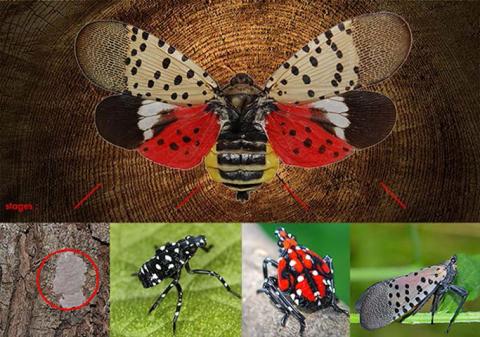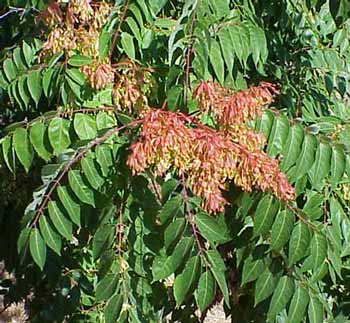Double Trouble Double Invasion

Spotted Lanternfly
The Spotted Lanternfly (Lycorma delicatula), an invasive insect native to China, was first detected in Pennsylvania in September 2014. It has moved into surrounding states, with the closest observations to NH having been in Connecticut.
Spotted lanternfly feeds on a wide range of fruit, ornamental and woody trees, but Tree of Heaven (Ailanthus altissima) is its preferred host. Spotted lanternflies can be spread long distances by people who move infested material or items containing egg masses. Egg masses are difficult to identify and can be hidden in difficult-to-access areas on cars, shipping crates, trailers, firewood, and camping equipment.
If allowed to spread in the U.S., this pest could seriously impact the country’s grape, orchard, and logging industries. Common NH crops that spotted lanternfly is known to attack include apples, peaches, cherries, grapes, and numerous forest trees like maple, oak, poplar, sycamore, walnut and willow.
The insect attacks the trees by piercing the trunk, twigs or leaves of a plant and sucking out sap. This causes the plants to ooze sugary sap, which can result in a fermented odor, followed by a buildup of sticky fluid (honeydew) on the trees and then on the ground underneath infested plants. The honeydew can then attract bees or cause secondary health issues for plants, like sooty mold!
Researchers, land managers and government regulators are working hard to head this insect off before it causes major damage in the US. Expect to hear more as protocols are developed in the coming years.
https://www.aphis.usda.gov/publications/plant_health/2014/alert_spotted_lanternfly.pdf

Tree of Heaven
Since Tree of Heaven (Ailanthus altissima) is a preferred food source for the spotted lanternfly, the NH Department of Agriculture Markets & Food is working hard to control this invasive tree as a method of both favoring native trees and preventing the spread of spotted lanternfly. Tree of Heaven is already is on NH’s prohibited invasive species list. See the Dept of Agriculture, Markets & Food’s fact sheet with more pictures here.
Tree of Heaven is an aggressive tree species native to China, and has found its way into disturbed habitats and urban areas in New Hampshire, especially along roadsides and railroad corridors. It is incredibly fast growing and if given the chance, can reach up to 100’ in height. I first saw it growing between the highway and the Merrimack River in Manchester. I noticed it because it is surprisingly pretty when in bloom in June, a major part of the reason it was initially imported in the 18th century. Look this summer to see if it is still there. From the car it looks like a sumac shrub, because of the long compound leaves. However, it can be distinguished from sumac by the smooth leaflets with 1-2 glandular notches at the base (see picture below). Another key diagnostic feature is a prominent brown pith (1/2- 3/4” in diameter) at the center of the twigs, which has a distinct rotten peanut odor. Once you smell it, you won’t forget it! The many big clumps of flowers produce thousands of wind- and water- dispersed seeds that will germinate under many conditions. If left to grow, tree of heaven has the potential to rapidly shade-out native plant species, reducing overall biodiversity. And worse yet, it will also attract the spotted lanternfly.
https://extension.unh.edu/blog/invasive-spotlight-tree-heaven
https://extension.unh.edu/resources/files/Resource000988_Rep1134.pdf See page 7
Though the edge of the leaflets are smooth, leaf glands at the leaflet bases are a good diagnostic feature. Due to their bumpy appearance, they are sometimes referred to as “teeth.”
 Tree of Heaven has very stout twigs, with the center ½-3/4” of each containing a light brown pith which exudes a smell of rotten peanuts.
Tree of Heaven has very stout twigs, with the center ½-3/4” of each containing a light brown pith which exudes a smell of rotten peanuts.

If you think you have found Tree of Heaven, please take pictures and contact the UNH Extension Infoline to verify the identification. Helping us find this invader is the first step in protecting our trees and farms!
----------
The author and Natural Resources Stewards would like to thank Forestry Field Specialist Ethan Belair, who contributed to this article.
About the Author
Anne Krantz admits, “I literally stumbled into the fascinating the Natural Resources Stewards Program and followed that with the comprehensive Master Gardener training.” Participating in a special training in 2009, Anne became part of the first team of volunteers to answer homeowner questions at the Education Center, an activity she continues to love.
“Because of these excellent education opportunities I now serve on my conservation commission, the NH Pesticide Board and the Rivers Management Advisory Council," she says. "I have also enjoyed UNH Extension's Big Tree program; I just found a flowering native chestnut tree this morning!”

